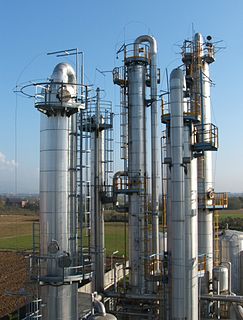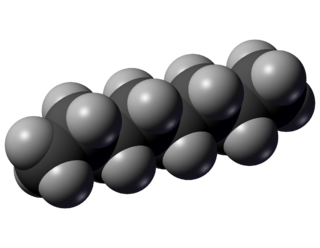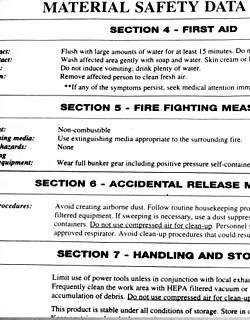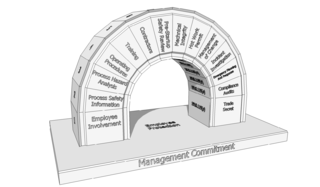
Chemical engineering is a branch of engineering that uses principles of chemistry, physics, mathematics, biology, and economics to efficiently use, produce, transform, and transport chemicals, materials, and energy. A chemical engineer designs large-scale processes that convert chemicals, raw materials, living cells, microorganisms, and energy into useful forms and products.
In toxicology, the median lethal dose, LD50 (abbreviation for "lethal dose, 50%"), LC50 (lethal concentration, 50%) or LCt50 is a measure of the lethal dose of a toxin, radiation, or pathogen. The value of LD50 for a substance is the dose required to kill half the members of a tested population after a specified test duration. LD50 figures are frequently used as a general indicator of a substance's acute toxicity. A lower LD50 is indicative of increased toxicity.
Phosgene is the chemical compound with the formula COCl2. A colorless gas, in low concentrations its odor resembles freshly cut hay or grass. Phosgene is a valued industrial building block, especially for the production of urethanes and polycarbonate plastics. However, it is very poisonous and was used as a chemical weapon during World War I where it was responsible for 85,000 deaths. In addition to its industrial production, small amounts occur from the breakdown and the combustion of organochlorine compounds.

Personal protective equipment (PPE) is protective clothing, helmets, goggles, or other garments or equipment designed to protect the wearer's body from injury or infection. The hazards addressed by protective equipment include physical, electrical, heat, chemicals, biohazards, and airborne particulate matter. Protective equipment may be worn for job-related occupational safety and health purposes, as well as for sports and other recreational activities. "Protective clothing" is applied to traditional categories of clothing, and "protective gear" applies to items such as pads, guards, shields, or masks, and others.

Octane is a hydrocarbon and an alkane with the chemical formula C8H18, and the condensed structural formula CH3(CH2)6CH3. Octane has many structural isomers that differ by the amount and location of branching in the carbon chain. One of these isomers, 2,2,4-trimethylpentane (isooctane) is used as one of the standard values in the octane rating scale.

A laboratory is a facility that provides controlled conditions in which scientific or technological research, experiments, and measurement may be performed.

A safety data sheet (SDS), material safety data sheet (MSDS), or product safety data sheet (PSDS) is a document that lists information relating to occupational safety and health for the use of various substances and products. SDSs are a widely used system for cataloging information on chemicals, chemical compounds, and chemical mixtures. SDS information may include instructions for the safe use and potential hazards associated with a particular material or product, along with spill-handling procedures. SDS formats can vary from source to source within a country depending on national requirements.
"NFPA 704: Standard System for the Identification of the Hazards of Materials for Emergency Response" is a standard maintained by the U.S.-based National Fire Protection Association. First "tentatively adopted as a guide" in 1960, and revised several times since then, it defines the colloquial "fire diamond" or "safety square" used by emergency personnel to quickly and easily identify the risks posed by hazardous materials. This helps determine what, if any, special equipment should be used, procedures followed, or precautions taken during the initial stages of an emergency response.

A chemical hazard is a type of occupational hazard caused by exposure to chemicals in the workplace. Exposure to chemicals in the workplace can cause acute or long-term detrimental health effects. There are many types of hazardous chemicals, including neurotoxins, immune agents, dermatologic agents, carcinogens, reproductive toxins, systemic toxins, asthmagens, pneumoconiotic agents, and sensitizers. These hazards can cause physical and/or health risks. Depending on chemical, the hazards involved may be varied, thus it is important to know and apply the PPE especially during the lab.

Process safety management system is a regulation promulgated by the U.S. Occupational Safety and Health Administration (OSHA). A process is any activity or combination of activities including any use, storage, manufacturing, handling or the on-site movement of highly hazardous chemicals (HHCs) as defined by OSHA and the Environmental Protection Agency.
Registry of Toxic Effects of Chemical Substances (RTECS) is a database of toxicity information compiled from the open scientific literature without reference to the validity or usefulness of the studies reported. Until 2001 it was maintained by US National Institute for Occupational Safety and Health (NIOSH) as a freely available publication. It is now maintained by the private company BIOVIA or from several value-added resellers and is available only for a fee or by subscription.
A chemical disaster is the unintentional release of one or more hazardous substances which could harm human health or the environment. Chemical hazards are systems where chemical accidents could occur under certain circumstances. Such events include fires, explosions, leakages or release of toxic or hazardous materials that can
cause people illness, injury, or disability.
The American Institute of Chemical Engineers (AIChE) is a professional organization for chemical engineers. AIChE was established in 1908 to distinguish chemical engineers as a profession independent of chemists and mechanical engineers.
The International Programme on Chemical Safety (IPCS) was formed in 1980 and is a collaboration between three United Nations bodies, the World Health Organization, the International Labour Organization and the United Nations Environment Programme, to establish a scientific basis for safe use of chemicals and to strengthen national capabilities and capacities for chemical safety.

An occupational hazard is a hazard experienced in the workplace. Occupational hazards can encompass many types of hazards, including chemical hazards, biological hazards (biohazards), psychosocial hazards, and physical hazards. In the United States, the National Institute for Occupational Safety and Health (NIOSH) conduct workplace investigations and research addressing workplace health and safety hazards resulting in guidelines. The Occupational Safety and Health Administration (OSHA) establishes enforceable standards to prevent workplace injuries and illnesses. In the EU a similar role is taken by EU-OSHA.

The U.S. Chemical Safety and Hazard Investigation Board, generally referred to as the Chemical Safety Board or CSB, is an independent U.S. federal agency charged with investigating industrial chemical accidents. Headquartered in Washington, D.C., the agency's board members are appointed by the president and confirmed by the United States Senate. The CSB conducts root cause investigations of chemical accidents at fixed industrial facilities.

Dibromodifluoromethane is a mixed halomethane. It is a colorless non-flammable liquid.
A recommended exposure limit (REL) is an occupational exposure limit that has been recommended by the United States National Institute for Occupational Safety and Health to the Occupational Safety and Health Administration (OSHA) for adoption as a permissible exposure limit. The REL is a level that NIOSH believes would be protective of worker safety and health over a working lifetime if used in combination with engineering and work practice controls, exposure and medical monitoring, posting and labeling of hazards, worker training and personal protective equipment. No REL has ever been adopted by OSHA, but they have been used as guides by some industry and advocacy organizations. RELs for chemical exposures are usually expressed in parts per million (ppm), or sometimes in milligrams per cubic metre (mg/m3). Although not legally enforceable limits, NIOSH RELs are considered by OSHA during the promulgation of legally enforceable PELs.

Occupational safety and health (OSH), also commonly referred to as occupational health and safety (OHS), occupational health, or workplace health and safety (WHS), is a multidisciplinary field concerned with the safety, health, and welfare of people at work. These terms also refer to the goals of this field, so their use in the sense of this article was originally an abbreviation of occupational safety and health program/department etc.










